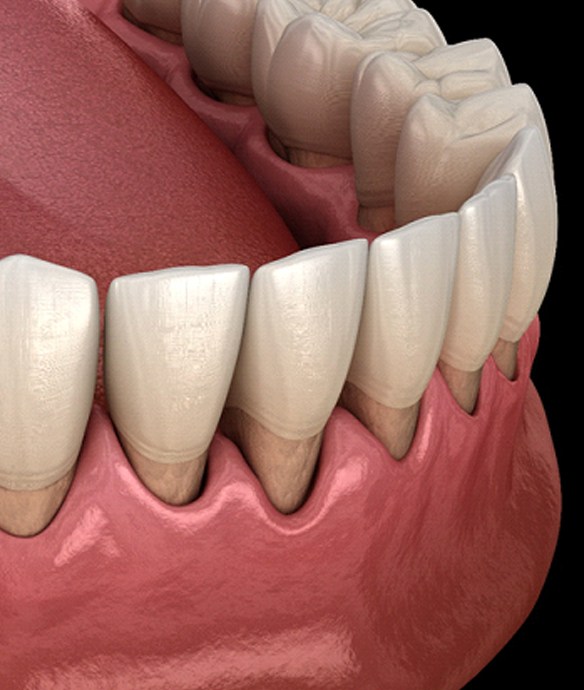
Gum Grafting – Lincoln, NE
Address Gum Recession for Good
Are your teeth appearing longer than usual? While this may only seem like a cosmetic imperfection at first, it can actually increase the level of gum and tooth sensitivity you experience. Since gum tissue is incapable of growing back on its own, gum grafting from our team of highly trained periodontists in Lincoln could be the solution you’re looking for. Feel free to learn more about the process below or give us a call directly to schedule a consultation with our periodontists!

Why Choose Pioneer Perio & Implant Dentistry for Gum Grafting?
- Kind and Caring Periodontists Serving You Care
- Modern Dental Technology In-House
- Dedicated to Minimally Invasive Treatments
What Causes Gum Recession?
Also known as periodontal disease, gum disease is considered to be one of the most common causes of gum recession. When first developing, it generally causes the gums to become red, swollen, and irritated. As it goes untreated, the bacteria responsible for this infection will start attacking the supportive bone tissue. This causes the bone to break down and the gums to recede, making it even easier for bacteria to form in the newly-created pockets in between the teeth and gums. With that said, gum recession can also occur due to:
- Teeth grinding and clenching (i.e. bruxism)
- Misaligned bite
- Brushing or flossing too hard
- Piercings that irritate gum tissue (including lip and tongue piercings)
- Genetics
How Does Gum Grafting Work?
During a gum grafting procedure, one of our periodontists will take gum tissue from another area of your mouth (usually the roof) and attach it to the area where it’s most needed. This ensures the tissue integrates with the body in the most effective way possible as well as functions as intended. In other circumstances, we may use donated tissue instead. Keep in mind that there are a few different types of gum grafting procedures that our office can perform.
What Types of Gum Grafting are Performed?
Ahead of your treatment, one of our periodontists will gladly answer any and all of your questions about your gum grafting. Following the end of the procedure, they will provide you with aftercare instructions to ensure the smoothest healing period possible.
With that said, there are three main types of gum grafting that can be performed.
The first is a free gingival graft, which uses tissue mainly from the palate. This works to make the gums thicker. The second is a subepithelial connective tissue graft. Gum grafts like these are meant to cover tooth roots, which can reduce sensitivity. The third and final type of gum graft is known as an acellular dermal matrix allograft, which makes use of donated tissue to restore damaged gums.
Gum Grafting FAQs
Is Gum Grafting a Painful Procedure?
A gum graft does involve detailed and careful dental surgery. However, our team will make absolute certain that you are as comfortable as possible throughout your treatment process. We utilize modern-day technology for effective pain management, such as local anesthesia to ensure that you’re pain-free. We can also provide various sedation services so that you can relax and feel much more at ease even before starting the procedure. During your visit, you shouldn’t feel any discomfort, but it’s normal to experience some soreness and sensitivity for several days following your treatment. We’ll give you instructions on how to manage your condition to make your recovery as smooth as possible.
When is Gum Grafting Necessary?
If you gum line is looking to be in bad condition due to issues like periodontal disease, then a gum graft might be required. In most cases, a gum infection can result in recession, which can only be treated with a grafting procedure. Periodontal disease can also lead the gums to deteriorate, even if your gum line isn’t receding. If left unchecked, the nerves can become exposed as well, and a gum graft will be the only way to keep them covered and safe.
How Long is Recovery After a Gum Grafting Treatment?
The average amount of time it takes patients to heal from gum grafting is usually up to a couple of weeks. Of course, this can be different from person to person, especially depending on how much grafting was necessary for their treatment plan. In any case, one of the best ways to ensure a swifter recovery after gum grafting is to refrain from eating hard and chewy foods, as these can be too abrasive for your gums and the roof of your mouth. You can also drink green smoothies as well as healthy liquids to help your mouth heal, including clean water.
Do Gum Grafts Look Natural?
The results of your gum grafting procedure should look completely natural once you’ve properly recovered. Anyone who sees will hardly notice the difference. Furthermore, the tissue we use to implant onto your gum line will be extracted from other mouth tissues in your oral cavity, so the results will usually look similar to your gum tissue. Our team will discuss the treatment process as well as what you can expect during your consultation, that way, there are no surprises after your procedure and you can feel confident about your decision.